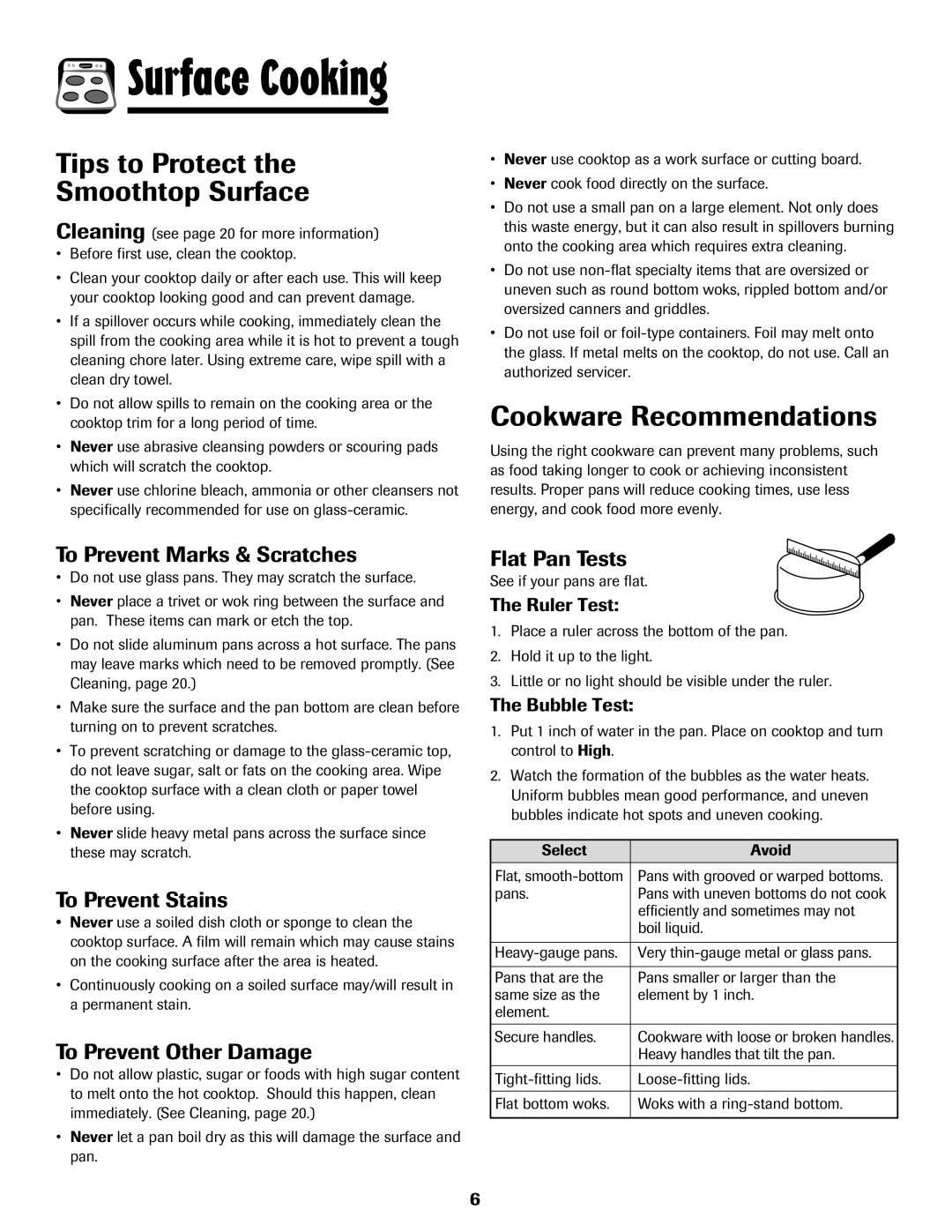
 Surface Cooking
Surface Cooking
Tips to Protect the
Smoothtop Surface
Cleaning (see page 20 for more information)
•Before first use, clean the cooktop.
•Clean your cooktop daily or after each use. This will keep your cooktop looking good and can prevent damage.
•If a spillover occurs while cooking, immediately clean the spill from the cooking area while it is hot to prevent a tough cleaning chore later. Using extreme care, wipe spill with a clean dry towel.
•Do not allow spills to remain on the cooking area or the cooktop trim for a long period of time.
•Never use abrasive cleansing powders or scouring pads which will scratch the cooktop.
•Never use chlorine bleach, ammonia or other cleansers not specifically recommended for use on
•Never use cooktop as a work surface or cutting board.
•Never cook food directly on the surface.
•Do not use a small pan on a large element. Not only does this waste energy, but it can also result in spillovers burning onto the cooking area which requires extra cleaning.
•Do not use
•Do not use foil or
Cookware Recommendations
Using the right cookware can prevent many problems, such as food taking longer to cook or achieving inconsistent results. Proper pans will reduce cooking times, use less energy, and cook food more evenly.
To Prevent Marks & Scratches
•Do not use glass pans. They may scratch the surface.
•Never place a trivet or wok ring between the surface and pan. These items can mark or etch the top.
•Do not slide aluminum pans across a hot surface. The pans may leave marks which need to be removed promptly. (See Cleaning, page 20.)
•Make sure the surface and the pan bottom are clean before turning on to prevent scratches.
•To prevent scratching or damage to the
•Never slide heavy metal pans across the surface since these may scratch.
To Prevent Stains
•Never use a soiled dish cloth or sponge to clean the cooktop surface. A film will remain which may cause stains on the cooking surface after the area is heated.
•Continuously cooking on a soiled surface may/will result in a permanent stain.
To Prevent Other Damage
•Do not allow plastic, sugar or foods with high sugar content to melt onto the hot cooktop. Should this happen, clean immediately. (See Cleaning, page 20.)
•Never let a pan boil dry as this will damage the surface and pan.
Flat Pan Tests
See if your pans are flat.
The Ruler Test:
1.Place a ruler across the bottom of the pan.
2.Hold it up to the light.
3.Little or no light should be visible under the ruler.
The Bubble Test:
1.Put 1 inch of water in the pan. Place on cooktop and turn control to High.
2.Watch the formation of the bubbles as the water heats. Uniform bubbles mean good performance, and uneven bubbles indicate hot spots and uneven cooking.
Select | Avoid |
Flat, | Pans with grooved or warped bottoms. |
pans. | Pans with uneven bottoms do not cook |
| efficiently and sometimes may not |
| boil liquid. |
|
|
Very | |
|
|
Pans that are the | Pans smaller or larger than the |
same size as the | element by 1 inch. |
element. |
|
|
|
Secure handles. | Cookware with loose or broken handles. |
| Heavy handles that tilt the pan. |
|
|
|
|
Flat bottom woks. | Woks with a |
|
|
6
